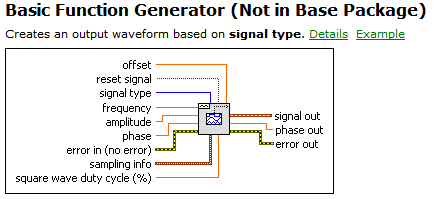| << Chapter < Page | Chapter >> Page > |

Dependiendo de la versión de LabVIEW de la que se disponga, se tendrá un mayor o menor número de controles y funciones disponibles.
Se puede cambiar el formato de presentación de cada una de las paletas, para ello se selecciona el botón View → View This Palette As en cada una de las paletas y se escoje la opción que le sea más cómoda para trabajar. Se Recomienda explorar el resto de los botones que se encuentran dentro del botón View para ajustar cada paleta como resulte más cómodo.
Esta paleta puede ser accedida desde cualquiera de las áreas de trabajo, seleccionando View → Tools Palette . Dispone de un botón de selección automática, si se encuentra seleccionado y se mueve el cursor sobre un objeto en el panel frontal o en el diagrama de bloque, LabVIEW automáticamente selecciona la herramienta correspondiente de la paleta de controles. En caso contrario, se deberá hacer la selección apropiada manualmente.

Para mayor comodidad, asegúrese que se encuentre seleccionado.
Como en cualquier otro programa, es muy importante obtener información de cómo operan las funciones y cuál es la sintaxis que debe seguirse para la programación.
Existen dos maneras básicas de obtener ayuda del programa, la primera es haciendo clic en Help → Show Context Help , a lo cual aparecerá la siguiente ventana:

Cuando se pase el cursor sobre cualquier VI, el contenido de la ventana Context Help cambiará y dará una ayuda rápida acerca del instrumento virtual sobre el cual esté el cursor.

La otra manera de tener acceso a la ayuda es haciendo clic derecho sobre el VI del cual quiere obtener información; se desplegará una ventada en la cual debe seleccionar en botón que corresponde a Help . Casi de inmediato se abrirá una nueva ventana donde aparecerá de maneta detallada la información relacionada con el VI que está buscando junto con el nombre y utilidad de cada uno de los terminales de los que dispone el instrumento.
Al igual que en otros lenguajes de programación, debe tenerse cuidado con el tipo de dato con el que se está trabajando; es decir, de acuerdo con el control o VI con el que se trabaje, éste podrá operar con datos del tipo: Boolean , single , double , binarios del tipo byte , Word , etc. LabVIEW hace la distinción asigna un color y un tipo de “cable” a cada estructura de datos; así éstos se pueden ver de la siguiente manera:

Por ejemplo, la línea delgada de color naranja representa datos de un solo tipo con valores decimales en los cuales se pueden encontrar los datos de precisión simple, doble o extendida. Las líneas delgadas de color azul son datos con o sin signo tipo byte , Word o Long . Las líneas más gruesas representan datos compuestos a los que se les llama Cluster , estos pueden estar compuestos con datos de diferente índole, para lo cual el programa se encarga de mantenerlos separados y organizados.
Una ventaja que ofrece LabVIEW es que al hacer conexiones entre VI con datos diferentes, en la mayoría de los casos, el programa se encarga de hacer la adaptación del tipo de dato simplificando, al usuario, la operación de conversión entre ellos. Por el contrario, si al programa se le hace imposible realizar la adaptación de los datos, entonces se presentará la conexión como un cable interrumpido.

Notification Switch
Would you like to follow the 'Señales y sistemas en matlab y labview' conversation and receive update notifications?